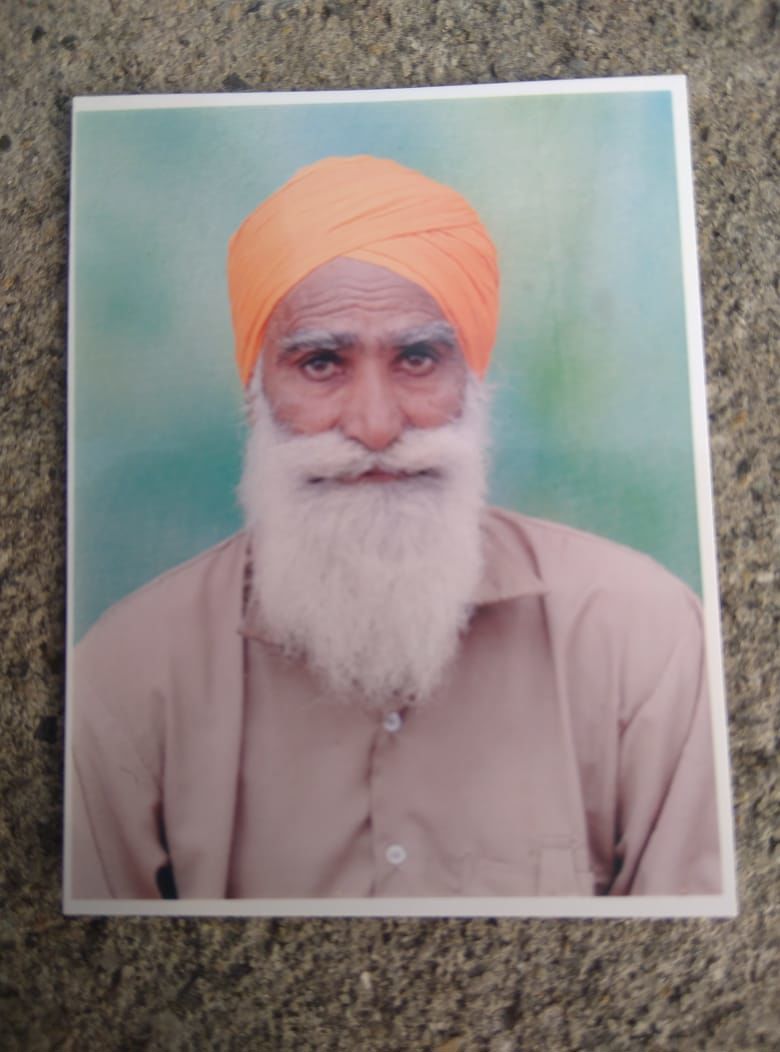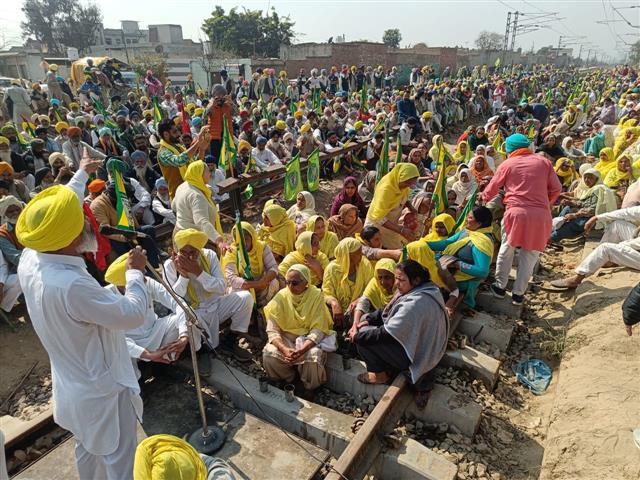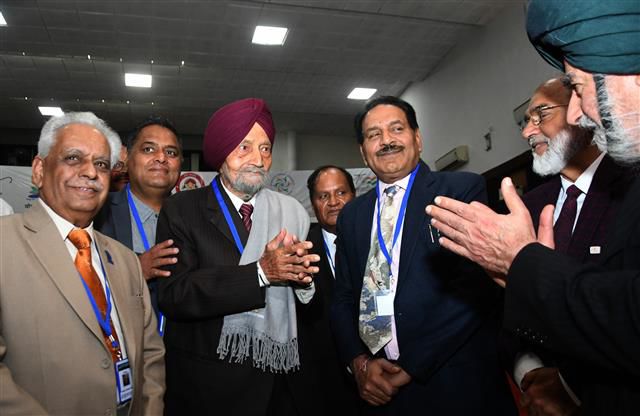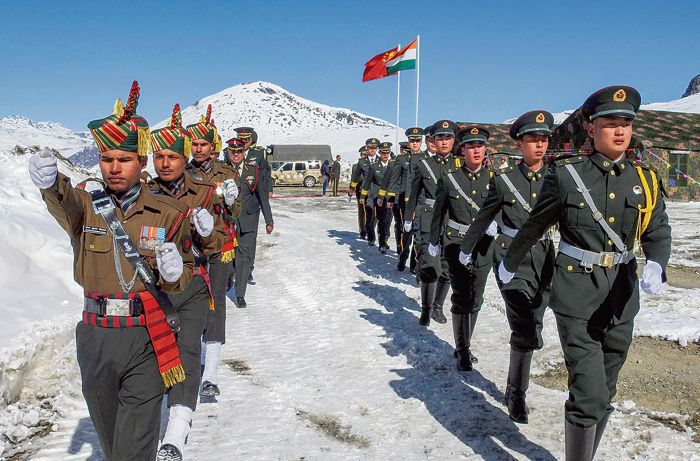Current Events :












Chandigarh, February 16
A 63-year-old farmer from Punjab’s Gurdaspur district, who was protesting at the Shambhu border near Haryana’s Ambala, died on Friday morning.
Gian Singh is said to have died of heart attack.
He complained of chest pain in the morning and was taken to the Civil Hospital in Punjab’s Rajpura. From there, he was rushed to Rajindra Hospital in Patiala, where doctors declared him brought dead, they said.
He is the first farmer who died in this year’s farmer protest.
Protest demonstrations by hundreds of farmers, who are marching from Haryana and Punjab, are going on at the Shambhu and Khanauri borders ever since.
Farmers began the march on Tuesday.
A third round of talks between protesting farmers and the government on Thursday remained inconclusive. The next round of talks would be held on Sunday.

Havildar Varinder Singh, a member of the Sikh Regiment in the Indian Army, has been awarded the prestigious Vishisht Seva Medal by President Droupadi Murmu for his outstanding contribution in developing a ‘Multipurpose Octocopter,’ an official statement revealed.
The ‘Multipurpose Octocopter,’ crafted by Singh, is a highly versatile drone designed not only for surveillance operations but also for executing various tasks such as grenade dropping, engaging aerial targets using weapons like the AK-47, and handling logistics operations.
Singh expressed his confidence that the ‘Multipurpose Octocopter’ will prove to be a valuable asset for the Indian Army. He highlighted its dual role as a surveillance tool and a weapon drone, emphasizing its ability to target enemies with precision using a four-hand grenade MGM rifle.
Indian Army officials acknowledged Havildar Varinder Singh’s remarkable achievement, stating, “For his accomplishments, Havildar Varindar Singh has been awarded the Vishisht Seva Medal by the President of India this year.”
The Vishisht Seva Medal (VSM), a distinguished decoration in the Indian Armed Forces, is conferred to recognize distinguished service of a high order. Crafted from bronze and adorned with a golden ribbon featuring three dark blue stripes, the VSM is awarded to personnel at all levels in the Indian Armed Forces. Instituted on January 26, 1960, as VSM Class-III, it was later renamed on January 27, 1967, with provisions for posthumous conferral.

New Delhi, Feb 14 (PTI) The CBI on Wednesday arrested the officer in-charge of the Ex-servicemen Contributory Health Scheme (ECHS) polyclinic in Uttar Pradesh’s Bulandshahr for allegedly demanding a monthly bribe of Rs 1 lakh for facilitating “smooth functioning” of medical services for the veterans in associated hospitals, officials said.
Accused Ashok Kumar Sharma was arrested in a trap operation conducted by the Central Bureau of Investigation (CBI) when he was receiving the first instalment of Rs 80,000 from a businessman whose firm was providing services related to the medical treatment of ECHS beneficiaries at four hospitals in Bulandshahr on outsourcing basis.
In his complaint, the businessman accused Sharma of mounting pressure on him to cough up the bribe saying or else, he would create problems for him, the officials said.After arresting Sharma, the federal agency conducted searches at his Greater Noida residence, they added.

Chandigarh, February 15
A panel of three Union ministers will hold a meeting with protesting farmer leaders in Chandigarh on Thursday for another round of talks amid the ongoing standoff between the agitators and security personnel at the Punjab-Haryana border.
This will be the third round of talks between the two sides: the previous two rounds of dialogue on February 8 and 12 remained inconclusive.
Farmers from Punjab are camping at the Shambhu and Khanauri borders of Punjab and Haryana seeking to march towards Delhi to press the Centre to accept their demands.
The farmer leaders said they would not make any fresh attempt to move towards the national capital till the meeting is held.https://ee35a9ee977750e30d9d9929dd61fbcc.safeframe.googlesyndication.com/safeframe/1-0-40/html/container.html 16:30 15 FebFarmer leader Gurnam Singh Charuni announces new agitation plans in Haryana
16:30 15 FebFarmer leader Gurnam Singh Charuni announces new agitation plans in Haryana
Gurnam Singh Charuni said Haryana toll plazas will be made ‘free’ for 3 hours on February 16.
He also announced a tractor parade in every tehsil of the state on February 17, and a joint meeting of all farmers’ organisations on February 18. 16:20 15 FebFarm leaders arrive in Chandigarh for talks with Central team
16:20 15 FebFarm leaders arrive in Chandigarh for talks with Central team
Chandigarh: Farm leaders Jagjit Singh Dallewal, Sarwan Singh Pandher and Jarnail Singh arrive for talks with the Central team at Mahatma Gandhi State Institute of Public Administration in Sector 26.

The meeting with three-member team of Union ministers Arjun Munda, Piyush Goyal and Nityanand Rai is to begin at 5 pm. 15:49 15 FebSome trains diverted
15:49 15 FebSome trains diverted
Some trains on the Delhi-Amritsar route were diverted after farmers squatted on tracks at many places in Punjab over the Haryana Police’s action against protesters. 15:37 15 FebBKU (Charuni) extends support to the agitating farmers
15:37 15 FebBKU (Charuni) extends support to the agitating farmers
Gurnam Singh after holding a meeting of office-bearers of his union announced to extend support to the agitating farmers and hold peaceful protests in Haryana. Kurukshetra: Bhartiya Kisan Union (Charuni) Gurnam Singh after holding a meeting of office-bearers of his union announced to extend support to the agitating farmers and hold peaceful protests in Haryana. 13:38 15 FebFarmers allege use of artillery by Haryana police
13:38 15 FebFarmers allege use of artillery by Haryana police 12:50 15 FebShahkot toll plaza in Jalandhar
12:50 15 FebShahkot toll plaza in Jalandhar 12:41 15 FebLadhowal, Azizpur toll plazas
12:41 15 FebLadhowal, Azizpur toll plazas 12:33 15 FebToll plazas made free
12:33 15 FebToll plazas made free 12:23 15 FebBathinda-Amabala railway track blocked
12:23 15 FebBathinda-Amabala railway track blocked 10:56 15 Feb30,000 tear gas shells ordered
10:56 15 Feb30,000 tear gas shells ordered 10:31 15 FebCalm and peace on Day 3 of farm protest
10:31 15 FebCalm and peace on Day 3 of farm protest 09:29 15 Feb3rd round of talks
09:29 15 Feb3rd round of talks 09:26 15 Feb‘We should be allowed to protest peacefully’: Pandher
09:26 15 Feb‘We should be allowed to protest peacefully’: Pandher 08:57 15 FebBorder sealed with barricades
08:57 15 FebBorder sealed with barricades 08:54 15 FebProtests at toll plazas
08:54 15 FebProtests at toll plazas 08:51 15 Feb‘Rail roko’ in Punjab today
08:51 15 Feb‘Rail roko’ in Punjab today
About The Author Tribune Web Desk
Tribune Web Desk
The Tribune Web Desk brings you the latest news, analysis and insights from the region, India and around the world. Follow the Tribune Wed Desk for not just breaking news stories but wide-ranging coverage of events.

Bikram Singh Grewal, a former chief engineer in the Public Works Department (PWD, buildings and roads branch), Punjab, passed away at the age of 100 on December 31, 2023. He was born in Lalton Kalan village of Ludhiana district on February 15, 1923. Exceptionally good in studies, he passed the matriculation examination conducted by the University of Punjab, Lahore, in the first division.
Grewal got admission in Khalsa College, Amritsar, in the non-medical stream. After getting the FSc (fellow of science) diploma, he applied for admission in MacLagan College of Engineering, Lahore. This was the only engineering college in north-western India at that time. He passed out in 1943 as a graduate in civil engineering. A year later, he was recruited as a subdivisional engineer (SDE) in the PWD. His first posting was at Narowal (which is a district headquarters now) in Sialkot district of Lahore division. As an SDE, he travelled on a bicycle to inspect building and road projects. About six years later, he was promoted as an executive engineer. Two of the oldest wings of Punjab Engineering College, Chandigarh — a successor to MacLagan College of Engineering, Lahore — were built under his supervision when he was the executive engineer, Ropar.
During his postings in Amritsar and Patiala, he oversaw the construction of two wings each of the government medical colleges in both cities. While posted in Hisar, he got a wing of the medical college constructed. After the creation of Haryana in November 1966, he was transferred to Punjab.
By the time he became a superintending engineer, he had gained a reputation as a scrupulously honest, no-nonsense officer. On several occasions, the corrupt elements in his department joined hands to wage a persistent propaganda war against him. Undeterred by the activities of his detractors, Grewal stood firm on his lofty principles. Eventually, all conspiracies against him collapsed like a house of cards and he became popular as an officer with impeccable integrity.
In 1971, Grewal was promoted to the rank of chief engineer. He served on this post for a decade before retiring in 1981. A fitness freak, he was a keen golfer who used to play at the Chandigarh Golf Club six days a week. A year ago, the Punjab Engineering College Old Students’ Association honoured him with the lifetime achievement award, which he amply deserved. He was the chief engineer when I was serving as the executive engineer (works) in the PWD in Patiala. It was a privilege to work under him. Grewal lived life to the fullest. We should celebrate his life rather than mourning his loss.


MEDIA reports about China moving its nationals into villages along the Line of Actual Control (LAC) and Ladakhi herders confronting soldiers of the Chinese People’s Liberation Army (PLA) sum up the state of affairs on the frontline. The prolonged standoff in Ladakh remains a security concern, even as it has been reported that Indian and Chinese troops were involved in skirmishes between September 2021 and November 2022.
Last month, Chief of Army Staff Gen Manoj Pande described the situation on the LAC as ‘stable but sensitive’. The impasse is entirely of China’s making, consequent to the PLA undertaking incursions in May 2020 in Pangong Tso, Gogra-Hot Springs, Galwan and Depsang areas of Ladakh so as to unilaterally change the status of the LAC. Considering the magnitude of the intrusions, it was obvious that the operation was approved by the Central Military Commission, China’s apex defence body headed by the President. The PLA’s hostile action, violating a series of bilateral border agreements, had taken India’s politico-military leadership by surprise, given that the strategic guidance mechanism put in place by PM Narendra Modi and President Xi Jinping had apparently been working well.
The Indian Army’s swift counter-deployment was aimed at restoring the status quo. However, having gained initial advantage, the PLA was in no mood to budge. It was only after India secured the Kailash Range in August 2020 that forced the Chinese to negotiate. Thereon, as a sequel to 20 rounds of military commanders talks alongside politico-diplomatic initiatives, the opposing forces have disengaged in three of the five contested areas; the Chinese have refused to yield ground in Depsang and Demchok.
The process of disengagement has come with new protocols, wherein erstwhile patrolling points (PPs) on the LAC — depicting the extent of patrolling limits — have now been replaced by ‘buffer zones’. Of the 65 PPs astride the LAC in Ladakh, 26 are now inaccessible, an aspect which has been flagged by the local police authorities in Leh during security review meetings. In the absence of de-escalation, the ground situation remains tense, with both sides deploying around 50,000 troops each. Clashes between the Indian Army and the PLA in the eastern sector (Arunachal-Tibet border) came to light when the citations for gallantry awards were read out during the investiture ceremonies held recently.
The PLA is continuing with its ‘nibbling’ tactics, evident from the clash with graziers in Kakjung area of Nyoma in Chushul. The herders were intercepted at the PPs 35-37 in Dungti village by over a dozen PLA personnel, escorted by three armoured vehicles. Chushul councillor Konchok Stanzin, who posted a video of the incident on social media, said the livelihood of locals had been taken away in the name of creating ‘buffer zones’.
The PLA’s grand design can be gauged from the massive military infrastructure development along the LAC in recent years. Major projects include twin bridges over Pangong Tso; a second national highway, G 695, through Aksai Chin; and the Nyingchi-Lhasa-Xigaze railway line (planned to be further extended to Gyirong and Burang, close to the Nepalese border). All airports in Tibet have been upgraded.
Further, the PLA is in the process of transforming Tibet into a formidable defence shield, in keeping with the directions of President Xi. To this end, 628 ‘well-off villages’ (Xiaokang) have been constructed; around a third of these are located in close proximity to the LAC. These dwellings are likely to act as the first line of defence; understood to be ‘dual use infrastructure’ — for both civil and military purposes.
Additionally, the ‘New Defence Law’ was enacted in 2021 to ensure better ‘civil-military fusion’. A year later, the ‘Border Defence Law’ was passed; it entails marking the borders with a view to consolidating control over the occupied areas. Giving Mandarin names to places in Arunachal Pradesh (Zangnan) and the Indian Ocean Region is part of China’s ‘Three Warfare Strategy’ to legitimise its claims.
China has deliberately downplayed the border issue to safeguard its economic interests and international image. As per China’s Charge d’Affaires Ma Jia, trade between the two countries reached a record $136.2 billion in 2023 (it was $135.8 billion in 2022, with a deficit of $73 billion in China’s favour). It is evident that Beijing has succeeded in delinking the border issue from economic ties despite New Delhi’s stance that the bilateral relations cannot be normal unless the boundary dispute is resolved.
Ladakh is faced with a two-front threat — Pakistan on the west and China on the east. Hence, a well-defined border defence strategy is an imperative — it is no longer just an option. The current mechanism of border management, with the Indo-Tibetan Border Police as the lead agency under the Ministry of Home Affairs, merits a holistic review. Our Vibrant Villages Programme must be integrated into the overall security plans. As civil-military cooperation is the key to effective defence, the grievances of the Ladakhi people must be addressed on priority. Political instability in this vulnerable border region will seriously impinge on national security.
Given the Dragon’s expansionist push, it is apparent that the situation on the LAC will remain sensitive. As de-escalation is unlikely in the near future, periodic skirmishes are set to be the new normal — a semblance of the ‘armed co-existence’ scenario of the early 1960s. At the strategic level, the situation may be perceived to be stable as the PLA is unlikely to undertake major operations, having already achieved its aim. However, China will continue to upgrade its military capabilities to maintain its operational edge and keep up the pressure on the border to serve its geopolitical interests.
THE release of eight former Indian Navy personnel, who were sentenced to death in Qatar, comes as a huge relief. It’s being viewed as an outcome of intense negotiations led by Prime Minister Narendra Modi. Credit must also go to all those in the diplomatic community and the security establishment who worked tirelessly behind the scenes. Their release marks the end of a harrowing period for the Navy veterans and their families. Yet, as a Congress leader put it succinctly, it is a matter of quiet celebrations for all Indians. The charges against the eight were grave. They were arrested in August 2022 for alleged espionage. In December last year, the death penalty was commuted to imprisonment. Neither the Qatari authorities nor New Delhi has made the charges public. It is unlikely that the cloak of secrecy would be lifted.
Working for a technology and consultancy firm, the veterans were arrested supposedly on the charges of spying on a submarine programme on behalf of Israel. Insinuations were made linking it to efforts aimed at preventing the development of military technologies in West Asia. The role of Pakistan also came under the scanner for trying to muddy the waters. Only the veterans can answer whether they were caught in a geo-political maelstrom not of their making, or acted irresponsibly and recklessly, or the charges against them were false. The Government of India lent them its full support, but such steadfast commitment cannot be taken for granted.
The Qatar case calls for putting in place protocols for re-employment of defence personnel. It should also serve as a terse reminder of the pitfalls of not reading the fine print while signing up for professional commitments, and the enormous risks that transgressions pose.

























































